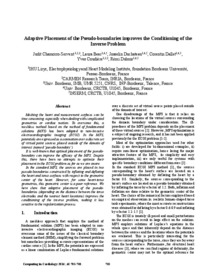Benvinguts al Repositori Digital de la UPF
Adaptive placement of the pseudo-boundaries improves the conditioning of the inverse problem
JavaScript is disabled for your browser. Some features of this site may not work without it.
Mostra el registre parcial de l'element
| dc.contributor.author | Chamorro Servent, Judit |
| dc.contributor.author | Bear, Laura |
| dc.contributor.author | Duchateau, Josselin |
| dc.contributor.author | Dallet, Corentin |
| dc.contributor.author | Coudière, Yves |
| dc.contributor.author | Dubois, Rémi |
| dc.date.accessioned | 2018-05-09T16:45:54Z |
| dc.date.available | 2018-05-09T16:45:54Z |
| dc.date.issued | 2016 |
| dc.identifier.citation | Chamorro Servent J, Bear L, Duchateau J, Dallet C, Coudière Y, Dubois R. Adaptive placement of the pseudo-boundaries improves the conditioning of the inverse problem. Comput Cardiol. 2016;43:705-8. DOI: 10.22489/CinC.2016.206-294 |
| dc.identifier.issn | 2325-8861 |
| dc.identifier.uri | http://hdl.handle.net/10230/34601 |
| dc.description.abstract | Meshing the heart and measurement surfaces can be time consuming, especially when dealing with complicated geometries or cardiac motion. To overcome this, a meshless method based on the method of fundamental solutions (MFS) has been adapted to non-invasive electrocardiographic imaging (ECGI). In the MFS, potentials are expressed as a summation over a discrete set of virtual point sources placed outside of the domain of interest (named ‘pseudo-boundary’). It is well-known that optimal placement of the pseudoboundary can improve the efficacy of the MFS. Despite this, there have been no attempts to optimize their placement in the ECGI problem as far as we are aware. In the standard MFS, the sources are placed in two pseudo-boundaries constructed by inflating and deflating the heart and torso surfaces with respect to the geometric center of the heart. However, for some heart-torso geometries, this geometric center is a poor reference. We here show that adaptive placement of the pseudoboundaries (depending on the distance between the torso electrodes and the nearest heart locations) improves the conditioning of the inverse problem, making it less sensitive to the regularization process. |
| dc.description.sponsorship | This study received financial support from the French Government as part of the “Investments of the Future” program managed by the National Research Agency (ANR), Grant reference ANR-10-IAHU-04 and from the Conseil Régional Aquitaine as part of the project “Assimilation de données en cancérologie et cardiologie”. |
| dc.format.mimetype | application/pdf |
| dc.language.iso | eng |
| dc.publisher | Computing in Cardiology |
| dc.relation.ispartof | Computing in Cardiology. 2016;43:705-8. |
| dc.rights | Licensed by their authors under the Creative Commons Attribution License 2.5 (CCAL). |
| dc.rights.uri | http://creativecommons.org/licenses/by/2.5/ |
| dc.title | Adaptive placement of the pseudo-boundaries improves the conditioning of the inverse problem |
| dc.type | info:eu-repo/semantics/article |
| dc.identifier.doi | http://dx.doi.org/10.22489/CinC.2016.206-294 |
| dc.rights.accessRights | info:eu-repo/semantics/openAccess |
| dc.type.version | info:eu-repo/semantics/publishedVersion |


